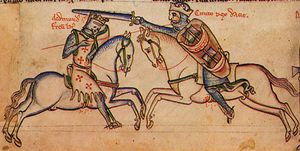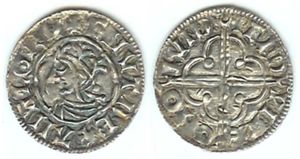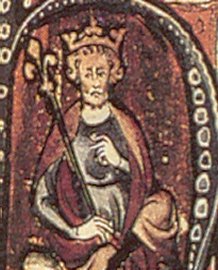كنوت العظيم
| Cnut | |
|---|---|
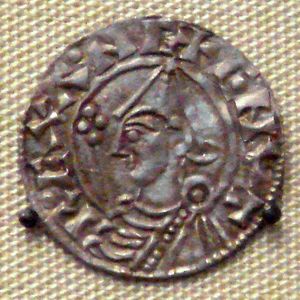 Coin of Cnut the Great from the المتحف البريطاني | |
| King of Denmark | |
| العهد | 1018–1035 |
| سبقه | Harald II of Denmark |
| تبعه | Harthacnut |
| King of England | |
| العهد | 1016–1035 |
| التتويج | 6 January 1017 (London) |
| سبقه | Edmund |
| تبعه | Harold |
| King of Norway | |
| العهد | 1028–1035 |
| سبقه | Olaf Haraldsson |
| تبعه | Magnus Olafsson |
| وُلِد | c. 985 – c. 995 Denmark |
| توفي | 12 November 1035 إنگلترة (Shaftesbury, Dorset) |
| الدفن | Old Minster, Winchester. Bones now in Winchester Cathedral |
| الزوج | Ælfgifu of Northampton Emma of Normandy |
| الأنجال | Svein Knutsson, King of Norway Harold, King of England Harthacnut, King of Denmark and England Gunhilda, Holy Roman Empress |
| البيت | House of Denmark |
| الأب | Sweyn Forkbeard |
| الأم | Świętosława / Sigrid/ Gunhild (detail)[1] |
Cnut the Great[2] (Old Norse: Knútr inn ríki;[3] c. 985 or 995 – 12 November 1035), more commonly known as Canute, was a king of Denmark, إنگلترة, Norway and parts of Sweden. After the death of his heirs within a decade of his own and the Norman conquest of England in 1066, his legacy was largely lost to history. Historian Norman F. Cantor has made the paradoxical statement that he was "the most effective king in Anglo-Saxon history", despite his not being Anglo-Saxon.[4]
Cnut was of Danish and Slavic descent. His father was Sweyn Forkbeard, King of Denmark (which gave Cnut the patronym Sweynsson, Old Norse Sveinsson). Cnut's mother was the daughter of the first duke of the Polans, Mieszko I; her name may have been Świętosława (see: Sigrid Storråda),[5][6][7] but the Oxford DNB article on Cnut states that her name is unknown.[8]
As a prince of Denmark, Cnut won the throne of England in 1016 in the wake of centuries of Viking activity in northwestern Europe. His accession to the Danish throne in 1018 brought the crowns of England and Denmark together. Cnut held this power-base together by uniting Danes and Englishmen under cultural bonds of wealth and custom, rather than sheer brutality. After a decade of conflict with opponents in Scandinavia, Cnut claimed the crown of Norway in Trondheim in 1028. The Swedish city Sigtuna was held by Cnut.[9] He had coins struck which called him king there, but there is no narrative record of his occupation.
The kingship of England lent the Danes an important link to the maritime zone between the islands of Great Britain and Ireland, where Cnut like his father before him had a strong interest and wielded much influence among the Gall-Ghaedhil.[10]
Cnut's possession of England's dioceses and the continental Diocese of Denmark – with a claim laid upon it by the Holy Roman Empire's Archdiocese of Hamburg-Bremen – was a source of great leverage within the Church, gaining notable concessions from Pope Benedict VIII, and his successor John XIX, such as one on the price of the pallium of his bishops. Cnut also gained concessions on the tolls his people had to pay on the way to Rome from other magnates of medieval Christendom, at the coronation of the Holy Roman Emperor. After his 1026 victory against Norway and Sweden, and on his way to Rome for this coronation, Cnut, in a letter written for the benefit of his subjects, stated himself "king of all England and Denmark and the Norwegians and of some of the Swedes".[11]
فتح إنگلترة
Landing in Wessex
التقدم شمالاً
حصار لندن
Completion of the Danish conquest
King of England
لم يكن الملك كنوت فاتحاً وكفى، بل كان إلى هذا حاكماً قديراً. ولسنا ننكر أنه لوث بداية حكمه بأعمال القسوة: فقد طرد من البلاد أبناء إدمند إيرنسد Edmund Ironside وأمر بذبح أخي إدمند ليمنع بذلك عودة الملوك الأنجيسكسون إلى العرش. لكنه لما رأى أن أرملة إثلرد وأبناءه لا يزالون أحياء في رون Rouen، تغلب على كثير من المشاكل بأن خطب إما Emma لنفسه (1017). وكانت هي وقتئذ في الثالثة والثلاثين من عمرها، وقبلت الخطبة وحصل كنوت بضربة واحدة على زوجة، وحلف مع دوق نورمندية أخي إما، وعلى عرش مكين أمين. وأصبح عرشه من تلك اللحظة نعمة على إنجلترا وبركة.
The government of England
فقد كبح جماح الأعيان المشاكسين الذين حطموا روح إنجلترا وفرقوا وحدتها، ووقى البلاد شر الغزاة في المستقبل، ووهبها أثني عشر عاماً من السلم غير المنقطعة واعتنق الملك الدين المسيحي، وشاد كثيراً من الكنائس، وأقام نصباً تذكارياً أسندون Assndun إحياء لذكرى الأنجلوسكسون والدنمرقيين الذين حاربوا في ذلك المكان، وحج بنفسه إلى قبر إدموند، ووعد بأن يتبع قوانين إنجلترا وأنظمتها القائمة فيها، ووفى بوعده فيما عدا حالتين اثنتين: فقد أصر على أن تكون حكومة المقاطعات التي أفسدها الأعيان الأتوقراطيون تحت سيطرة عملائه هو، واستبدل بكبير الأساقفة وزيراً من غير رجال الدين ليكون كبير مستشاري التاج، وأنشأ طائفة من العمال الإداريين والموظفين المدنيين كان لهم الفضل في جعل حكومة البلاد ثابتة مستمرة، وكان عماله كلهم تقريباً، بعد سني حكمه الأولى المزعزعة، من الإنجليز. وقد جمع بين تاجي الدنمرقة وإنجلترا، ثم أصبح في عام 1028 ملكاً على النرويج، ولكنه كان يحكم مملكته الثلاثية من مدينة ونشستر.
وكان الغزو الدنمرقي حلقة في سلسلة الغزوات الأجنبية الطويلة وفي الامتزاج العنصري اللذين انتهيا بالفتح النورمندي وأنتجا آخر الأمر الشعب الإنجليزي. فقد امتزجت دماء الكلت والغاليين، والإنجليز والسكسون والجوت، والدنمرقيين والنورمان، بالزواج أو بغيره من الوسائل، فخلقت من البريطانيين أهل البلاد في زمن الرومان، وهم الذين ليست لهم ميزة ولا قدرة على الابتكار، خلقت منهم قراصنة عهد الملك إلزبث الصخابين، وفاتحي العالم الصامتين في القرون التالية. ولقد جاء الدنمرقيون إلى إنجلترا، كما جاء إليها الألمان وأهل الشمال، بحب للبحر يكاد يبلغ درجة الوجد والهيام، واستعداد لقبول دعوة البحر الغادرة إلى المغامرة والاتجار في أقاصي البلاد، أما من الجهة الثقافية فقد كانت غزوات الدنمرقيين كارثة على البلاد، وقف في أثنائها فن البناء فلم يخط خطوة إلى الأمام، وانحل فن زخرفة الكتب فيما بين عامي 750، 950؛ كما وقفت النهضة العلمية والأدبية التي شجعها ألفرد، وفعلت غزوات الشماليين ما فعلته في غالة نفسها فأخذت تقضي على أعمال شارلمان المجيدة.
Affairs to the East

Statesmanship
King of Denmark
Journey to Rome
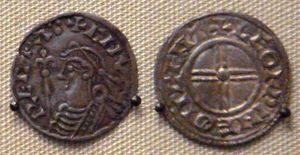
King of Norway and part of Sweden
Influence in the western sea-ways
Relations with the Church
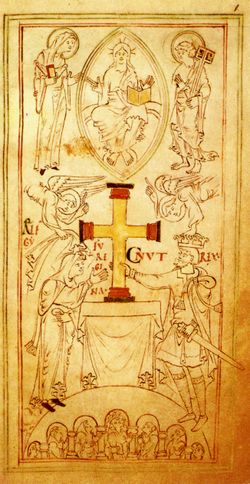
Death and succession
ولو أن أجل كنوت طال لأمكنه أن يصلح الأضرار التي أنزلها مواطنوه بالبلاد، ولكن شئون الحرب والحكم تبلى الناس سراعاً، فلقد مات كنوت عام 1035 ولما يتجاوز سن الأربعين؛ وخلعت النرويج نير الدنمرقيين على الفور، واضطر هارثكنوت Harthacnut بن كنوت الذي عينه قبل موته ولياً لعهده أن يكرس كل جهوده لحماية الدنمرقة من غزو النرويجيين؛ وحكم ابن آخر من أبنائه يدعى هيرلت هيرفوت Herald Harefoot إنجلترا خمس سنين؛ ثم مات؛ وحكمها هارثكنوت عامين توفي بعدها سنة 1042، واستدعى من نورمنديا قبل وفاته ابن إثرل وإما الباقي على قيد الحياة، واعترف بهذا الأخ الأنجلوسكسوني غير الشقيق وارثاً لعرش إنجلترا.
Bones at Winchester
Marriages and issue
- 1 – Ælfgifu of Northampton
- Daughter (c. 1012 - 1020), drowned in Bosham Creek in 1020, aged eight and was buried in Bosham Church.[12]
- Sweyn Knutsson, King of Norway
- Harold Harefoot, King of England
- 2 – Emma of Normandy
- Harthacnut, King of Denmark and England
- Gunhilda of Denmark, wed Henry III, Holy Roman Emperor.
Family tree
Ruler of the waves
Cnut's skalds
انظر أيضاً
Notes
- ^ Cnut's mother is the subject of historical debate. Some sources identify as her Gunnhilda, others say she is apocryphal or that there is insufficient evidence to name her. According to Medieval chroniclers Thietmar of Merseburg and Adam of Bremen, Cnut was the son of a Polish princess who was the daughter of Mieszko I and sister of Boleslaw I: this has been linked to Cnut's use of Polish troops in England and Cnut's sister's Anglicized Slavic name, Santslaue.
- ^ Bolton, The Empire of Cnut the Great: Conquest and the Consolidation of Power in Northern Europe in the Early Eleventh Century (Leiden, 2009)
- ^ Modern languages: دنماركية: Knud den Store or Knud II, نرويجية: Knut den mektige, سويدية: Knut den Store.
- ^ Cantor, The Civilization of the Middle Ages, 1995:166.
- ^ Encomiast, Encomium Emmae, ii. 2, pg. 18
- ^ Thietmar, Chronicon, vii. 39, pgs. 446-447
- ^ Trow, Cnut, p. 40.
- ^ M. K. Lawson, Cnut, Oxford Dictionary of National Biography, 2005
- ^ Graslund, B.,'Knut den store och sveariket: Slaget vid Helgea i ny belysning', Scandia, vol. 52 (1986), pp. 211–238.
- ^ Forte, et al., Viking Empires, p. 196.
- ^ Lawson, Cnut, p. 97. The Anglo-Saxon kings used the title "king of the English". Canute was ealles Engla landes cyning – "king of all England."
- ^ "Bosham - Early History". Bosham: Historic village near Chichester. bosham.org. Retrieved 19 مايو 2012.
وصلات خارجية
- Canute the Great
- Canute (Knud) The Great – From Viking warrior to English king
- Vikingworld (Danish) – Canute the Great (Knud den Store)
- Time Team – Who was King Cnut?
- Northvegr (Scandinavian) – A History of the Vikings (Search)
- Images from the British Library's collections
| ألقاب ملكية | ||
|---|---|---|
| سبقه Edmund Ironside |
King of all England 1016–1035 |
تبعه Harold Harefoot |
| سبقه Harald II |
King of Denmark 1018–1035 |
تبعه Harthacnut |
| سبقه Olaf the Saint |
King of Norway 1028–1035 مع Hákon Eiríksson (1028–1029) Sveinn Alfífuson (1030–1035) |
تبعه Magnus the Good |
- Articles containing دنماركية-language text
- Pages using Lang-xx templates
- Articles containing نرويجية-language text
- Articles containing سويدية-language text
- Short description is different from Wikidata
- Use dmy dates from October 2010
- 995 births
- 1035 deaths
- Anglo-Norse monarchs
- Burials at Winchester Cathedral
- Cnut the Great
- Danish people of Polish descent
- English people of Polish descent
- Danish monarchs
- ملوك إنگليز
- Norwegian monarchs
- Viking Age monarchs
- ملوك كاثوليك

